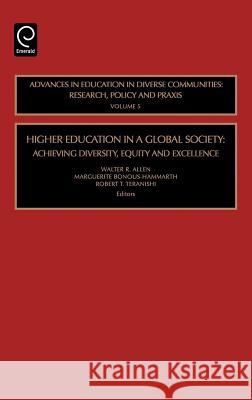Higher Education in a Global Society: Achieving Diversity, Equity and Excellence » książka
Higher Education in a Global Society: Achieving Diversity, Equity and Excellence
ISBN-13: 9780762311828 / Angielski / Twarda / 2005 / 494 str.
The "problem of the 21st century" is rapidly expanding diversity alongside stubbornly persistent status and power inequities by race, ethnicity, gender, class, language, citizenship and region. Extensive technological, economic, political and social changes, along with immigration, combine to produce a global community of great diversity and interpenetration. Unfortunately, this global community continues to be fractured by extreme disparities in wealth and power, divided into "haves" and "have-nots." Universities around the globe can play critical roles in economic development and sociocultural exchange. Where different communities interact, overlap, exchange and compete for scarce resources, complex challenges are presented. Current discourse often views difference and diversity as problems; however, a growing scholarship reframes difference and diversity as potential resources. This volume presents research into the consequences of difference and diversity for higher education. An international group of scholars reflects on the challenges and prospects of diversity, difference and inclusion for universities in their respective societies. Various theoretical and empirical perspectives are used to better understand how diverse populations and expectations intersect to influence higher education and societies globally. Diversity and difference are defined broadly to encompass specific national contexts and their particular emphases on race, ethnicity, gender, culture, language, religion, sexual orientation and/or region. We find that around the world, higher and tertiary institutions confront the "diversity imperative" with varying approaches, success and "best practices." This volume identifies challenges and opportunities that diversity poses for higher education. It provides international comparisons of how diversity affects higher education and of the salience and impact of diversity in higher education. It outlines practical, effective strategies for managing diversity in higher education across different societies.











